Introduction
Why is there such a dichotomy among Fortune500 companies on the value of a proactive and sustaining innovation workplace? Nowadays, COVID-19 changing market dynamics coupled with continual economic disruption, business disintermediation, and revolutionary technology introduction should be compelling grounds for business leaders to champion a robust corporate innovation culture and personality. Still, these trends are not encouraging a mainstream of businesses to challenge the status quo and take bold and decisive actions to remain competitive, continually enriching, and changing their product portfolio and organizational practices.
COVID-19 Lessons Learned: Innovation as a Strategy
“The well-laid plans organizations had were quickly made irrelevant. Being adaptive and responding quickly to change is the key to navigating this disruption. The focus of business strategy has been shifted away from some ideal future state and the roadmaps to get there, toward architecting the organization to be adaptive — innovation has become strategy.”
Gartner
History shows that there is an array of leading companies that have experienced real consequences for their lack of appreciation for enterprise innovation initiatives.
For example, only 52 companies have remained on the prestigious Fortune500 list from its start in 1955 to 2019. Statistically, 10.4% of the original 1955 Fortune 500 companies remain, and about 89% have either gone bankrupt, merged, or been acquired, or exist but removed from the list.
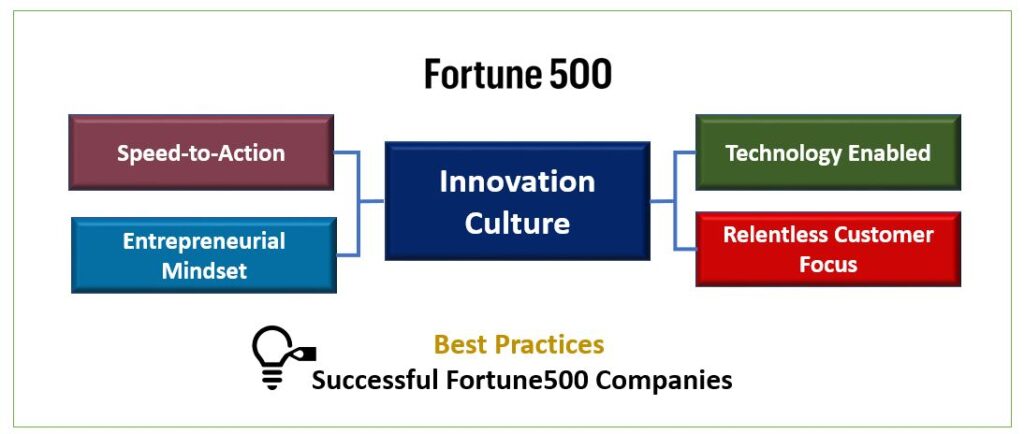
Why do so many companies fail to maintain their place on the Fortune500? Why have some continued their prominent position since 1955, with a number even improving their standings? Are there any inherent corporate behaviors and practices that allow for continual success and positive recognition year over year? These are questions that need answering by a company’s management, with practical experience and market intelligence, as they strategize near and long-term plans.
Historic events support that executive-sponsored and employee population-supported innovation culture is mission-critical for market success. There are numerous examples of recognized brands, some that were market leaders, and commanded significant competitive advantages that failed to maintain their product leadership with either inadequate, delayed, or no decisions on reacting smartly and quickly to customer requirements and competition.
Outlined in the below table are some of the more noteworthy business failure case studies for Blackberry, Blockbuster, and Kodak.
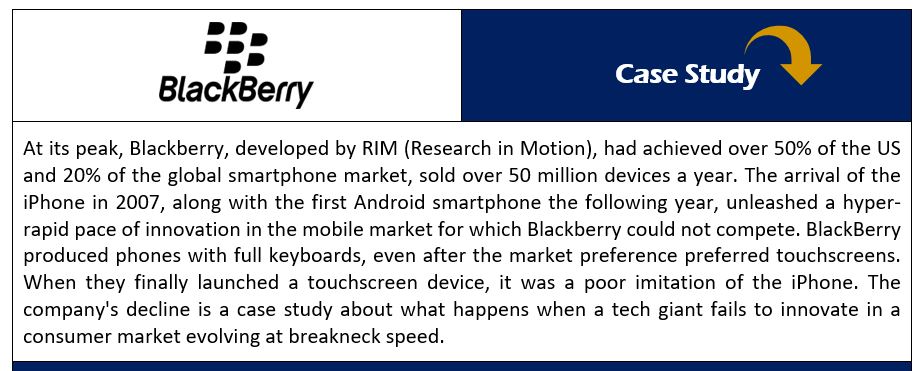
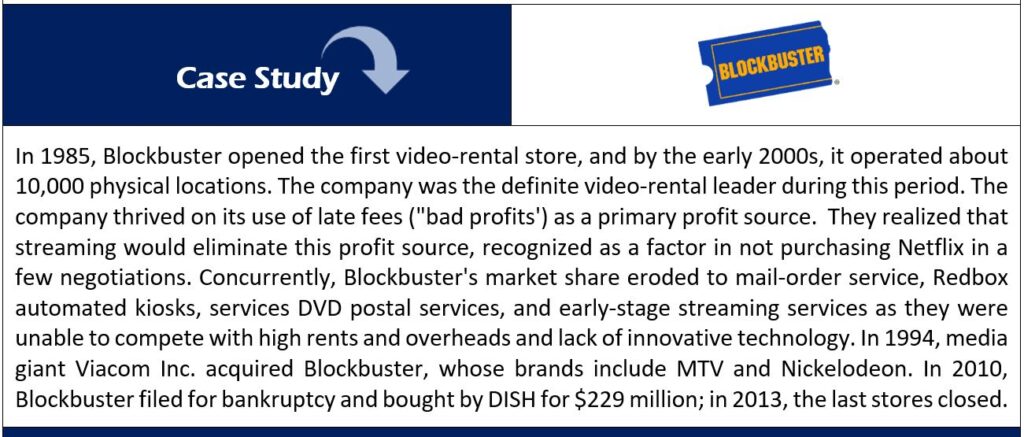
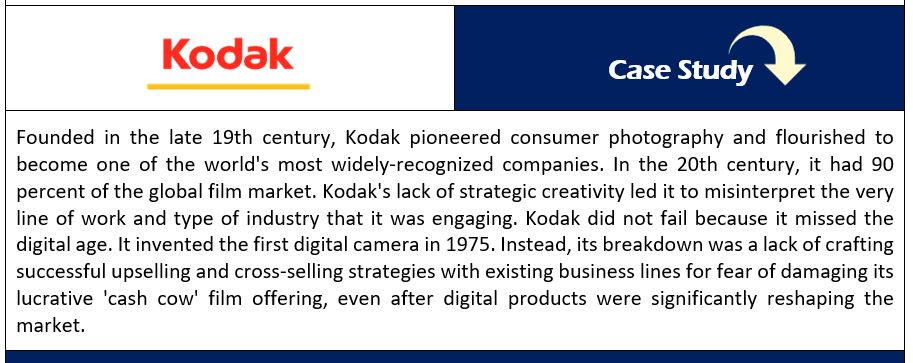
“Some men look at things the way they are and ask why? I dream of things that are not and ask why not?”
Robert F. Kennedy
Innovation does not fit nicely into one general definition type and as prescribed by companies across the broad business continuum. There are also many variations of the innovation’s types supported within service offerings from the top consulting companies. The example of a generic innovation type model, outlined below, is a practical definition of organizational innovation.
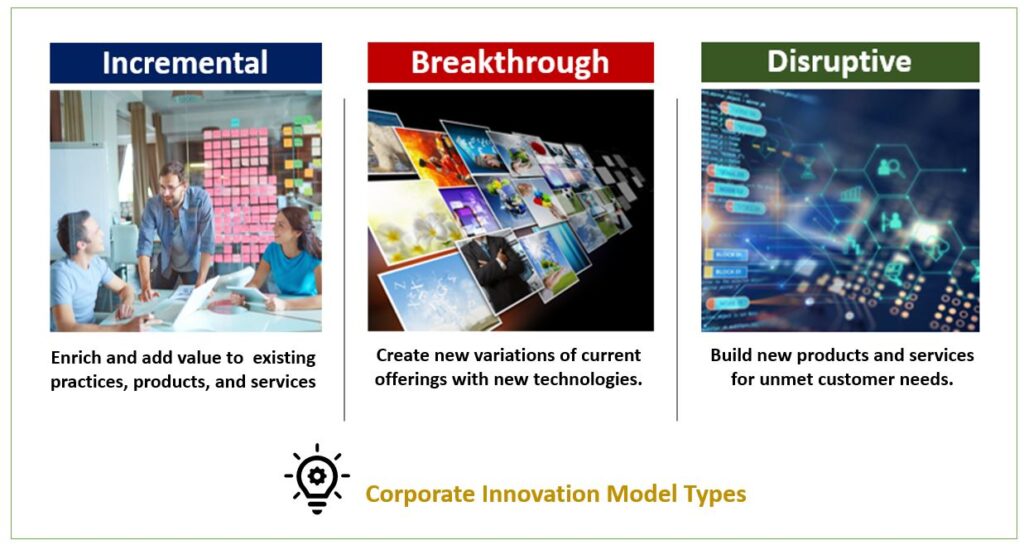
Innovation, in all forms, is convoluted, fraught with risk, and usually a costly undertaking. The top innovation companies generally think big and are willing to change their culture, appropriately fund, and devote human and technology resources to exploit problem and opportunity situations to reap significant potential rewards. These businesses embrace structured practices that manage and assess a broad pipeline of ideas and concepts, keeping what works, discarding what does not, and learning and adjusting from failure quickly. Successful innovation is rooted in aligning creative ideas with the organization’s strategic goals, initiatives, and business models.
“There are different ways to do innovation. You can plant a lot of seeds, not be committed to any particular one of them, but just see what grows. And this really isn’t how we’ve approached this. We go mission-first, then focus on the pieces we need and go deep on them and be committed to them.”
Mark Zuckerberg
The Lexicon: Creativity and Innovation
There is much confusion on the meanings of creativity and innovation and a tendency to view them as interchangeable. Strictly speaking, they are very different in their application. In summary, creativity is the prerequisite to change, and both are critical activities of the same value chain. Success is the result of the effective progression of new ideas from creativity to innovation activities. While creativity supports the capability to crystalize new and unique concepts and hypotheses, innovation is the enactment of that creativity in the form of new solutions, processes, and products.
Creativity is crucial because it is a catalyst for innovation, and there is no innovation without creativity.

Many companies have set up formal creativity roles, whereas others use an informal structure and collaboration to uncover new ideas and concepts. The success of the creative effort depends mostly on the effectiveness of ‘handoff’ to a corporate entity responsible for corporate innovation initiatives. Without a policy-driven and streamlined process for the initial idea discovery effort, the realization of a valued production outcome for organizational changes will be at risk.
Without creativity and innovation, a business would follow similar generic patterns of their competitors in production, marketing, promotion, sales practices, and customer service. Creativity is essential for companies, especially when the market is dependent on innovative emerging technology. The collaboration of creative minds can drive creative business thinking to a higher level.
Shown below are further descriptions of recognized creativity and innovation characteristics.
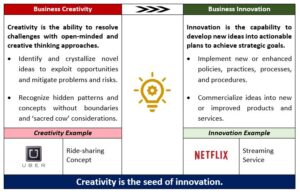
Research reveals that creative thinking is inherently unsettling and entails breaking traditional ideas and concepts and forming new connections between different regions of the brain. This condition results in cultivating different thinking skills and deliberate exposure to new experiences, human collaborations, knowledge-building, and formal learning sessions.
Creativity Myths & Misconceptions
Many creativity myths and misconceptions have been written about and discussed in the business community, including:
- Creativity is inherent in one’s heritage or genes.
- Creativity only comes from creative types of people.
- Unlimited resources improve creativity.
- The creativity trait does not support learning.
- Time pressure fuels creativity.
- Creativity is only about artistic expression.
None of these myths are true. Creativity draws from many human abilities that can be cultivated and refined.
“To sustain success in dynamic environments, companies must balance two vital activities. They must run the business reliably and efficiently, and they must change the business rapidly and effectively. Too little focus on innovation leads to a static enterprise that will fail to adapt. Too little emphasis on operations leads to poor quality, high costs, and dangerous risks to customers and to the business. Most large companies today have tilted too far toward bureaucracy, starving innovation. Crises make this deficiency painfully obvious but only for a while.”
Bain & Company – Harvard Business Review
The Innovation Corporate Culture
Increasingly, business success today goes to the company that can continually develop the most creative product or service to meet the targeted market segment’s ‘pain points’ and unmet needs. The innovation culture stimulates the advancement of creative thinking and change throughout the enterprise, aided by powerful employee empowerment and commitment.
Encouraging employees to adopt creative thinking as a standard approach and providing time and resources to explore new areas to explore is a receipt for successful discovery. The organizations that institutionalize innovation within their culture are those with a desire to create and maintain a competitive advantage continually, thereby allowing change to take root and flourish. The strategic outcome is the continuous availability of exciting, attractive, and revenue-producing new products and services and constant enrichment of the organizational practices.
Corporate innovation is commonly tacitly on display through the positive values, practices, and behaviors that employees exhibit collectively in providing and supporting high-quality products and services to customers.
As presented below, there are five examples of excellent innovative cultures, identified in BCG The Most Innovative Companies 2019 that are well recognized by their value-add practices, products, and services and success.
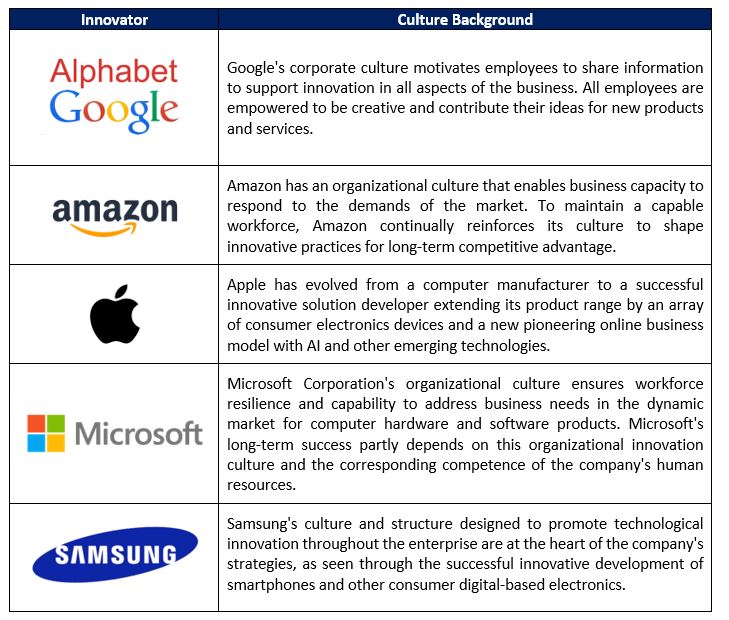
The Google X Lab named for a failed project shows that Google knows that failure is part of the path to success. It’s been the incubator for Google’s most significant projects, including drones, Google Glass, self-driving cars, and smart home appliances.
The most innovative companies are also predictably the most competitive in their target market segments as they yearly report consistent high growth, profitable products and services, and high employee productivity.
The biggest challenge to a thriving innovation culture is tolerance of existing organizational behaviors and policies that refute or discount the use of ideas from non-conventional or different sources, reluctant to accept sweeping change, and strongly admonish failure. Companies that foster innovative thinking encourage the in-depth discovery of ‘pain point’ problems and opportunities to quickly generate ideas for improvement of the current operating environment and development of new practices, products, services, and practices.
What differentiates the innovative companies shown above from their competitors? There is no standard ‘one size fits all’ guide of the characteristics required for a successful business. There are many qualities recognized as essential for the empowerment of an innovative corporate culture over the years. Outlined below are a set of practices with backgrounds in many of top innovative companies.
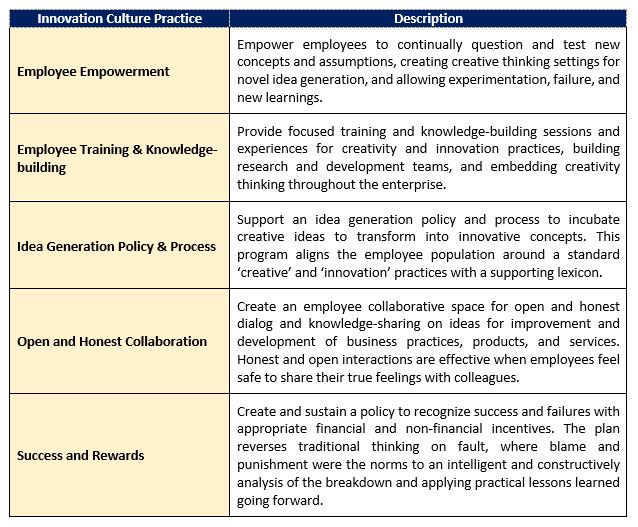
Creativity stimulates new ideas, challenges employees’ way of thinking, and identifies and exploits innovation opportunities. Success in a world of accelerating change and disruption, innovation is mandatory! A thriving innovation culture provides the business with a range of valuable benefits for the enterprise, as shown in the graphic below.

“I think frugality drives innovation, just like other constraints do. One of the only ways to get out of a tight box is to invent your way out.”
Jeff Bezos
The Creativity Engine and Process
Creativity is an engine and process consisting of formal steps and activities that are interdependent and connected, with an end or goal, or an expected result. In his 1926 classic, The Art of Thought, Graham Wallas presented the creative process in four structured stages. Although variations of his approach appeared over the years, Wallas’ framework remains the standard, albeit with enrichments such as a fifth stage.
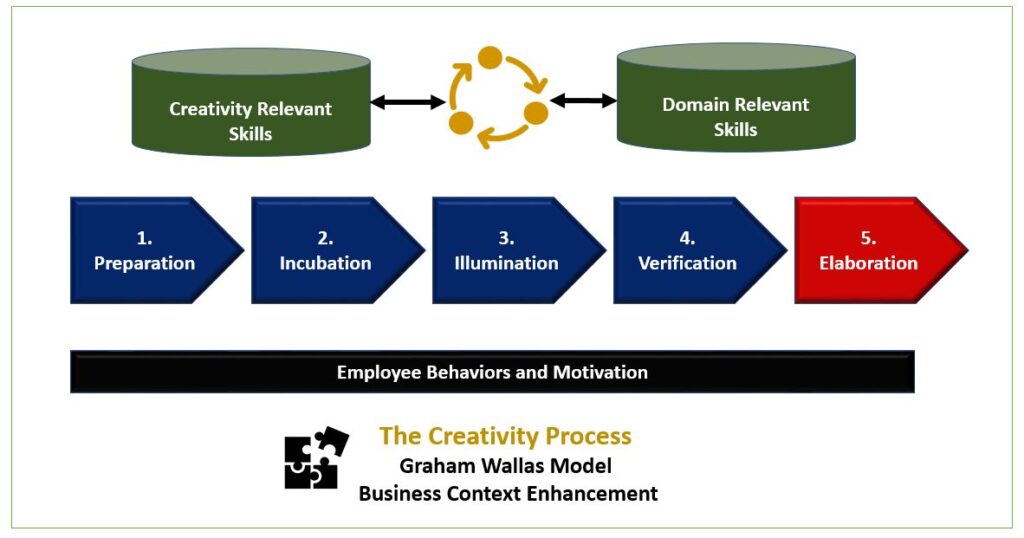
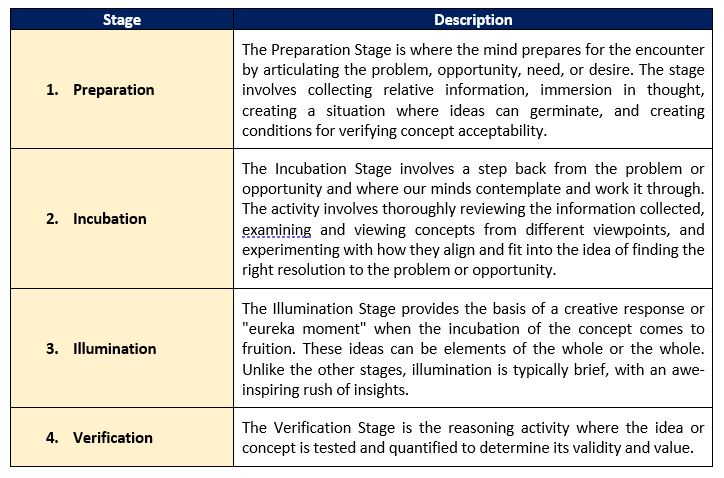
The creativity/innovation discipline has seen many enrichments of the original Graham Wallas Model over the years. The most notable improvement included adding a fifth stage for Elaboration, as described below. This new stage provided for the handoff of the original idea conceived and validated in the four initial stages to an innovation activity for development, commercialization, and implementation.

“The only way you survive is you continuously transform into something else. It’s this idea of continuous transformation that makes you an innovation company.”
Ginni Rometty
Creative Thinking Approaches
The three most widely used creative thinking approaches include:
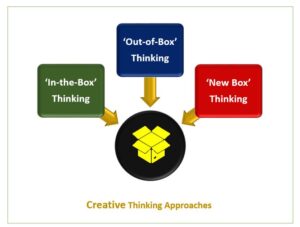
In-the-Box’ Thinking
This approach is thinking traditionally, bound by old, nonfunctional, or limiting structures, rules, or practices. The ‘box,’ with its implication of rigidity and squareness, symbolizes constrained and unimaginative thinking within an organizational division, group, and team.
‘Out-of-the-Box’ Thinking
This approach is more than just a cliché as it describes non-conformal, creative thinking, and is about not doing the same thing that everyone else does. It supports challenging problems and opportunities in atypical ways, thinking creatively and freely, and encouraging frequent encounters to the status quo. This activity deviates from generally accepted organizational policies, norms, and common expectations, and discounts ‘sacred cows’ to the benefit of solving the problem of exploiting the opportunity.
‘New-Box’ Thinking
This approach applies to the identification and acceptance of new ideas as they need to be:
- Synthesized by rearranging and reconstructing through dot-connecting then,
- Refined and implemented within the new innovation-required organizational context.
When people think in new boxes, they learn how to ask the right questions to open up the most promising doors to creativity.
Edward De Bono, the psychologist, and inventor created the term Lateral Thinking in 1967, developed it as a structured creativity technique that encourages people to think outside their standard thinking patterns.
Role of Visionary Leadership
An innovation culture requires visionary leaders that visualize and effectively communicate an inspiring vision and motivate confidence and positive change within the enterprise. This sense of company union fosters robust relationships among employee and management, strengthen collaboration, and help attain business goals with less controversy and risk more rapidly. Visionary leaders have the unique ability to look farther than others into the future and exhibit a steadfast focus on exploiting opportunities believed by naysayers to be unfeasible.
The below qualities generally dictate how visionary leaders respond to the challenges inherent in driving innovation and change.

Who are the top and most innovative and visionary leaders today?
The Forbes 2019 America’s Most Innovative Leaders report place Jeff Bezos and Elon Musk tied for first place. As the founders of Amazon and Tesla, Bezos and Musk collectively generated over US$1 trillion in the past ten years.
Presented below is the 2019 Forbes innovation leader ranking and commentary on their leadership style.
“Visionary leadership is widely seen as key to strategic change. That’s because visionary leadership does not just set the strategic direction — it tells a story about why the change is worth pursuing and inspires people to embrace the change.”
Harvard Business Review
The Way Forward
At Knowledge Compass we bring together nearly four decades of thought leadership in business and technology strategy, the latest tools and best practices, and a seasoned consultant team with the competencies and talent to help our clients improve productivity and profitability of all enterprise business and support activities.
Knowledge Compass explores and develops valuable new insights from business, technology, and science by embracing the powerful technology of ideas and brainstorming. Our consultants engage customers in challenging discussion and experimentation to expand the boundaries of business science and practice and translate creative ideas into practical solutions from within and beyond business.
Working with Knowledge Compass means a collaborative approach to understanding your current business model, strategies, and key business requirements and goals.
We enable organizations to transform and deliver improved value by ensuring employees adapt and make the most effective use of creativity and innovation practices in culture, strategy, infrastructure, and processing. Our consultants have a deep understanding and appreciation of the social and business factors that support an innovative culture aligned with the corporate personality and behaviors.
Knowledge Compass provides consulting services with the use of an array of Frameworks, Analyses Tools, and Interactions from their Best Practices Consultant Toolbox.
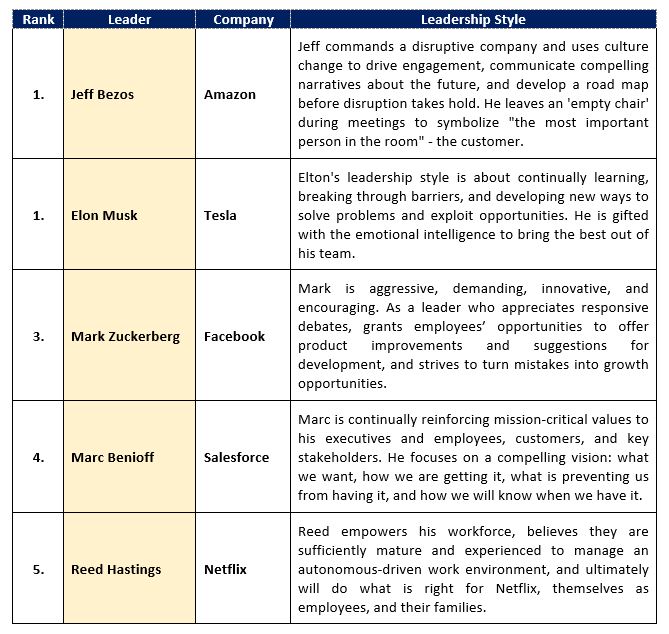



0 Comments